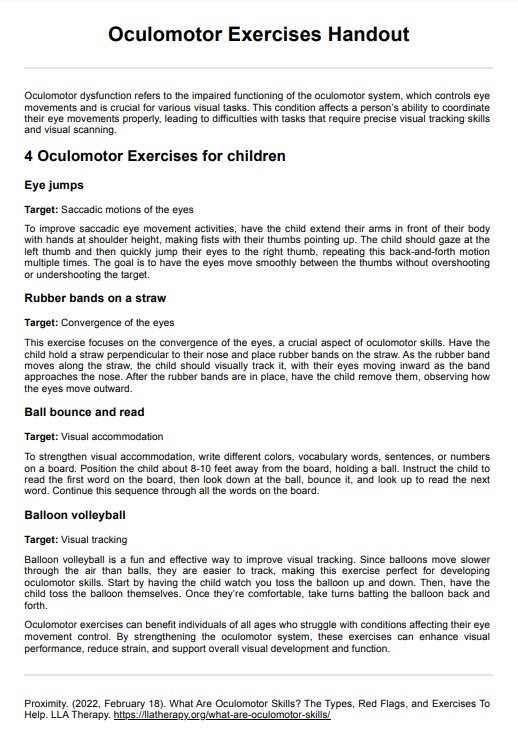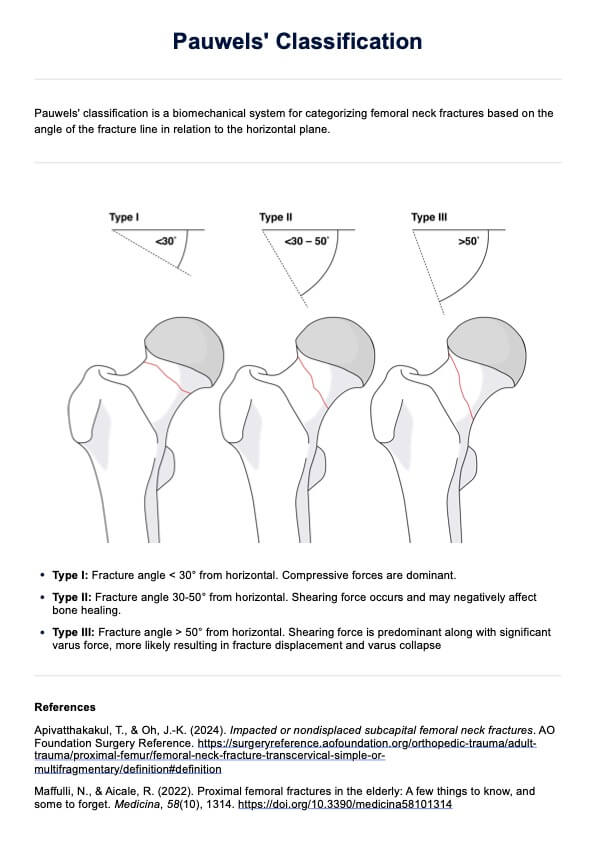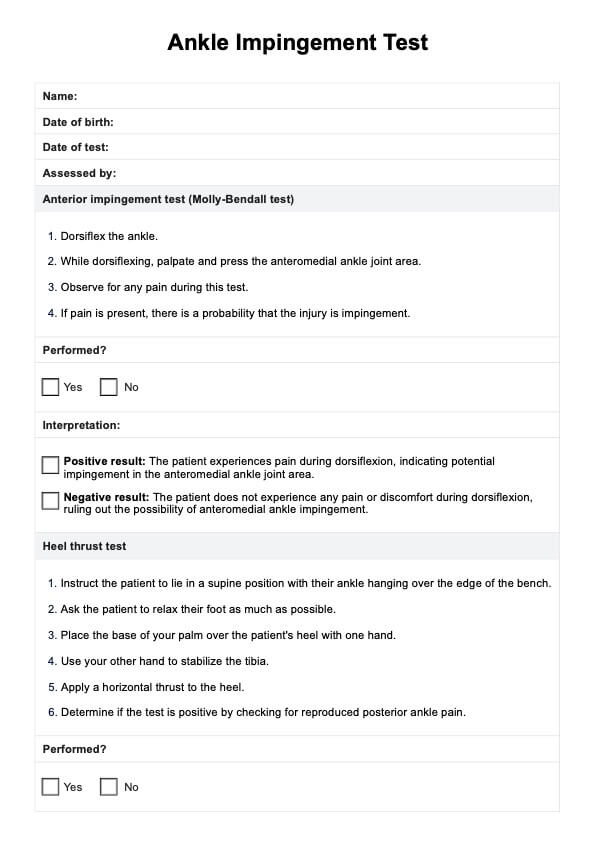Oculomotor Exercises
Improve your eye movements and coordination with Oculomotor Exercises with Carepatron's free PDF handout and effectively practice at home.


What is oculomotor dysfunction?
Oculomotor dysfunction refers to the impaired functioning of the oculomotor system, which controls eye movements and is crucial for various visual tasks. This condition affects a person’s ability to coordinate their eye movements properly, leading to difficulties with tasks that require precise visual tracking skills and visual scanning, such as reading or writing. Individuals with oculomotor dysfunction may experience issues with head movement as they attempt to compensate for their eyes' inability to smoothly follow moving objects or shift focus between different visual targets.
The dysfunction can manifest in poor ocular motor skills, including challenges with maintaining steady eye movement or accurately moving the eyes between fixed points. For example, a person might struggle to write letters neatly or keep up with writing tasks in general. To resolve this issue, you may prescribe vision therapy as a treatment option. Vision therapy aims to improve oculomotor skills through specific exercises designed to enhance the coordination and control of eye movement activities.
Oculomotor Exercises Template
Oculomotor Exercises Example
Importance of Oculomotor Exercises
Oculomotor exercises are essential for developing and maintaining proper eye movement control, particularly in children, as the oculomotor system continues to refine until they reach kindergarten age. By this stage, a child should be able to control their eye movements and smoothly track a target without unnecessary head motions. These skills are crucial for daily activities, as vision plays a vital role in everything from reading and writing to overall coordination.
For children with oculomotor dysfunction, these exercises are especially important as they help improve visual tracking and scanning abilities, which are necessary for tasks like following a line of text or writing accurately. Additionally, oculomotor exercises can benefit individuals of all ages who struggle with conditions affecting their eye movement control.
4 Oculomotor Exercises for children
Oculomotor exercises are vital tools for occupational therapists working with children who need to enhance their oculomotor skills. These exercises help improve visual attention, coordination, and eye movement control, all of which are essential for academic tasks and daily activities. Here are excellent
Eye jumps
Target: Saccadic motions of the eyes
To improve saccadic eye movement activities, have the child extend their arms in front of their body with hands at shoulder height, making fists with their thumbs pointing up. The child should gaze at the left thumb and then quickly jump their eyes to the right thumb, repeating this back-and-forth motion multiple times. The goal is to have the eyes move smoothly between the thumbs without overshooting or undershooting the target.
Rubber bands on a straw
Target: Convergence of the eyes
This exercise focuses on the convergence of the eyes, a crucial aspect of oculomotor skills. Have the child hold a straw perpendicular to their nose and place rubber bands on the straw. As the rubber band moves along the straw, the child should visually track it, with their eyes moving inward as the band approaches the nose. After the rubber bands are in place, have the child remove them, observing how the eyes move outward.
Ball bounce and read
Target: Visual accommodation
To strengthen visual accommodation, write different colors, vocabulary words, sentences, or numbers on a board. Position the child about 8-10 feet away from the board, holding a ball. Instruct the child to read the first word on the board, then look down at the ball, bounce it, and look up to read the next word. Continue this sequence through all the words on the board.
Balloon volleyball
Target: Visual tracking
Balloon volleyball is a fun and effective way to improve visual tracking. Since balloons move slower through the air than balls, they are easier to track, making this exercise perfect for developing oculomotor skills. Start by having the child watch you toss the balloon up and down. Then, have the child toss the balloon themselves. Once they’re comfortable, take turns batting the balloon back and forth.
How to use our Oculomotor Exercises Handout?
Our Oculomotor Exercises Handout is a valuable resource designed to guide healthcare practitioners and individuals in effectively using oculomotor exercises to improve eye movement control and visual skills. Follow these simple steps to make the most of the handout.
Step 1: Access and download the handout
To begin, access the Oculomotor Exercises Handout from our Resource Library. From there, ownload the handout in PDF. Ensure you have a printed or digital copy ready to share with your patients or for personal use.
Step 2: Review the handout
Before introducing the handout to patients, take a moment to thoroughly review its contents. Familiarize yourself with the exercises, their purpose, and how they should be performed. This step is crucial for effectively guiding patients through the exercises and addressing any questions they may have.
Step 3: Educate the patient with the handout
When working with a patient, introduce the handout as a tool to support their oculomotor skills development. Educate them on the importance of the exercises and demonstrate how each one should be performed. Encourage them to follow the handout regularly and provide any additional guidance to ensure they understand and can complete the exercises independently.
How do professionals benefit from using this handout?
Professionals, such as occupational therapists and vision specialists, benefit greatly from using the Oculomotor Exercises Handout as it provides a structured and reliable tool for addressing oculomotor dysfunction in their patients.
The handout simplifies the process of implementing targeted exercises by offering clear, step-by-step instructions that can be easily followed during sessions or at home. This not only enhances the effectiveness of therapy but also ensures consistency in patient care.
Additionally, the handout serves as an educational resource, helping professionals to explain the importance of oculomotor skills to patients and their families. By incorporating this handout into their practice, professionals can improve patient outcomes, streamline their treatment plans, and provide a higher standard of care.
Commonly asked questions
Ocular motor skills can be improved through regular oculomotor exercises that focus on enhancing eye movement control, visual tracking, and coordination. These exercises help strengthen the eye muscles and improve the brain's ability to process visual information.
Oculomotor dysfunction can be addressed with vision therapy, which includes specific exercises designed to improve eye movement accuracy and coordination. Consistent practice of these exercises, often guided by an occupational therapist, can significantly reduce symptoms.
The six eye exercises protocol typically includes saccades, smooth pursuits, convergence, divergence, accommodation, and eye-hand coordination exercises. These are designed to target different aspects of eye movement and visual focus.
Exercises for the iris, often referred to as pupillary exercises, involve activities that encourage the pupils to constrict and dilate, such as focusing on near and far objects. These exercises can help improve the responsiveness of the iris to changes in light and focus.







































































































